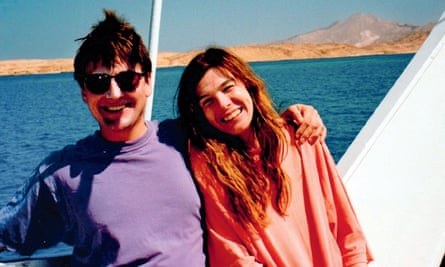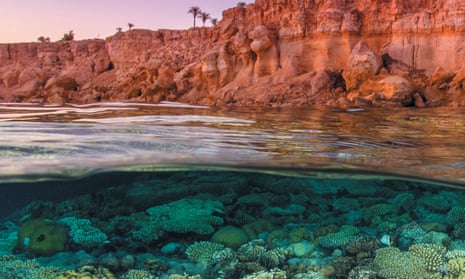In August of this year, Gail Bradbrook, a co-founder of Extinction Rebellion, called for the widespread ingestion of psychedelic substances to help bring about a transformation in attitudes to the climate crisis and the living world. The proposal may sound far-fetched, but it has some science behind it. Studies show that, in the right setting, psychedelics can not only be effective against addiction and depression but can also help people feel more connected to nature. Yet the living world of tropical coral reefs surpasses in wonder and beauty anything engendered in the human mind by psychedelics. As the evolutionary biologist Leslie Orgel once said, evolution is cleverer than you are. A reef will convince you that it also has a bigger, stranger and subtler imagination.
There are few better guides to the glories of reefs than Callum Roberts. Reef Life is a vibrant memoir of the joys, as well as the grind, of a research career beginning in the 1980s that has spanned a golden age of coral reef science. It is also a fine introduction to the ecology of reefs and the existential threats they now face. Roberts is well equipped for the task. He is chief scientific adviser to Blue Planet II, and has given us two of the best books in the last 15 years about the ecology of the sea and its fate in human hands: An Unnatural History of the Sea and Ocean of Life.
Roberts revels in the details of life on a coral reef. A mantis shrimp, for instance, has “a carapace of mottled green edged with a thin red line like the piping on an iced cake”. Its eyes, “frosted glass balls on blue stalks, marked with a horizontal line like the slot of a helmet visor”, give it “an almost supernatural power” to see linear and circularly polarised light. This book also addresses the major questions regarding human responsibility and possibilities for change. We live at what is probably the zenith of coral reef evolution in hundreds of millions of years in terms of their diversity and productivity, but human action might bring this all to an end within a few generations: “It is an extraordinary position that I still grapple with daily to understand.”

Coral reefs are, arguably, life’s greatest miracle. Hugely productive ecosystems in nutrient-poor waters, they harbour a quarter of all marine diversity in less than 0.1% of the oceans’ extent. On a healthy reef, top predators such as sharks are abundant, while life lower down the food chain appears to be scarce – a seeming inversion of the “pyramid” we’re familiar with on land, where a vast savannah supports a herd of wildebeest, but only a few lions or leopards. (The solution to the apparent paradox is that life at the lower trophic levels on reefs provides abundant resources for predators but turns over very fast.)
Despite their intense vibrancy, reefs are also vulnerable, both to direct human impacts such as overfishing, pollution and insensitive development, and to indirect impacts of the large-scale combustion of fossil fuels, which result in global heating and changes to ocean chemistry. In the past four decades, three pulses of heat have devastated many reefs around the world, including, in 2016 and 2017, the Great Barrier Reef. The risk to their future is unlike anything they have experienced in millions of years.
There is already a rich literature, and to a lesser extent a filmography, on the threats they face and what, if anything, can best protect them. Among the highlights are John “Charlie” Veron’s sober and devastating A Reef in Time, the gripping documentary film Chasing Coral, and Coral Whisperers, Irus Braverman’s fluent account of 100 or so interviews with leading scientists and conservation managers. Journalists continue to document how the destruction of reefs impacts on the mental health of researchers, who report “ecological grief”. Roberts is a humorous, determined expert, who has spent more than three decades trying to come to terms with such issues. As his book begins, he is a fresh-faced student assisting in some of the first detailed studies of coral reefs on the Saudi Arabian coast of the Red Sea. Working in harsh conditions, blundering into embarrassing situations and sometimes exposing himself to danger, he is carried forward by “thunderclaps of wonder”. A few years later, and now a respected marine biologist, he is assessing the aftermath of the huge releases of oil into the Persian Gulf by Saddam Hussein’s forces as they fled from Kuwait in the first Gulf war. Remarkably, some of the reefs here – among the most northern in the world – survive, having escaped the tide of pollution.

Further adventures, from the Caribbean to the Maldives and far beyond, follow. In 2013, Roberts is in Australia supporting scientists and environmentalists who are trying to slow and even reverse the impact on the Great Barrier Reef of the development of new port facilities for the export of coal. By this time, scientists are warning that even a relatively small increase in the global average temperature, let alone the 2º Celsius or more that now looks probable, is likely to have a devastating impact on most of the world’s reefs. Roberts finds himself deployed as part of what turns out to be an effective campaign to change minds regarding the proposed coastal development; by 2015 the opposition Labor Party come to power with a promise to protect the reef. It is poignant to read this in 2019, long after Australian voters have returned a government that does not appear to believe that the climate crisis should be a cause for concern.
“I don’t know a single coral expert who is not haunted by doubt,” Roberts writes. “It is already possible to glimpse the most dystopian of futures.” But, he stresses, there are “hopeful strands”. It has been found, for example that some corals can survive in hotter and more acidic waters than was previously thought. Further acclimation and adaptation may be possible in some instances. Genetic engineering to make more heat-resistant corals may be feasible, though controversial. But above all, according to Roberts, there is a role for well-managed marine parks. “Most coral reef damage of the last couple of decades has been from manageable stresses like pollution, overfishing and development rather than climate change.” Where these pressures are reduced, corals and the endless forms of life they support have a fighting chance.
In a moving penultimate chapter, he describes a visit to Palmyra Atoll in the Pacific, the world’s most isolated reef, and currently among its most intact. Palmyra is part of a huge US conservation zone called the Pacific Remote Islands Marine National Monument. Roberts, with his irrepressible warmth and passion, concludes: “Now is the time for action, not mourning. There is everything to play for.”
